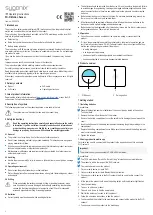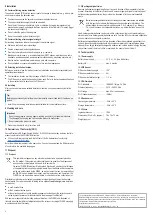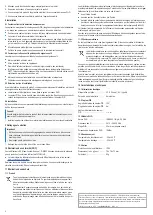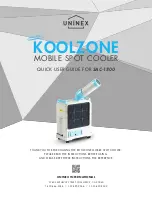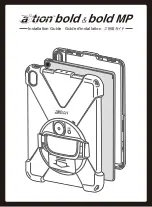
4
8 Installation
8.1 Factors affecting motion detection
The passive infrared (PIR) motion sensor reacts to changes in temperature, e.g. when a per-
son or animal enters the detection area.
■
Position the sensor so the object moves across the detection area.
■
The correct installation height should be observed.
■
Do not point the sensor at radiators, lights, or objects with varying temperatures (e.g.
electronic equipment), and objects that may move due to the flow of air. This may trigger
the sensor unintentionally.
■
Do not install the product behind glass.
■
Keep the sensor away from direct sunlight.
8.2 Factors affecting wireless signal strength
Surrounding objects can reduce the strength of the wireless signal:
■
Walls and reinforced concrete ceilings
■
Coated or vaporised insulating glass panes
■
Proximity to metallic and conductive objects (e.g., radiators)
■
Broadband interference, e.g. in residential areas (DECT phones, mobile phones, radio
headsets, wireless speakers, wireless weather stations, baby monitoring systems, etc.)
■
Electric motors, transformers, power-supply units and computers
■
Poorly shielded or uncovered computers or other electrical appliances
8.3 Selecting installation location
Before you install or place the product, select an installation location that meets safety and
operational requirements.
■
The installation location is within the range of the Wi-Fi network.
■
The PIR sensor is within the desired activation zone. Refer to the technical specifications
in these instructions for details on the PIR sensor.
8.4 Installing
After you have determined a suitable installation location, you can permanently install the
product.
Tip:
Before you permanently install the product, temporarily secure it and test if it works as ex-
pected.
1. Install the product using installation material suitable for the installation surface.
9 Cleaning and care
Important:
– Do not use aggressive cleaning agents, rubbing alcohol or other chemical solutions.
They damage the housing and can cause the product to malfunction.
– Do not immerse the product in water.
1. Clean the product with a dry, fibre-free cloth.
10 Declaration of Conformity (DOC)
Conrad Electronic SE, Klaus-Conrad-Straße 1, D-92240 Hirschau hereby declares that this
product conforms to the 2014/53/EU directive.
■
Click on the following link to read the full text of the EU declaration of conformity:
www.conrad.com/downloads
Enter the product item number in the search box. You can then download the EU declaration
of conformity in the available languages.
11 Disposal
11.1 Product
This symbol must appear on any electrical and electronic equipment placed on
the EU market. This symbol indicates that this device should not be disposed of
as unsorted municipal waste at the end of its service life.
Owners of WEEE (Waste from Electrical and Electronic Equipment) shall dispose
of it separately from unsorted municipal waste. Spent batteries and accumulators,
which are not enclosed by the WEEE, as well as lamps that can be removed from
the WEEE in a non-destructive manner, must be removed by end users from the
WEEE in a non-destructive manner before it is handed over to a collection point.
Distributors of electrical and electronic equipment are legally obliged to provide free take-
back of waste. Conrad provides the following return options
free of charge
(more details on
our website):
■
in our Conrad offices
■
at the Conrad collection points
■
at the collection points of public waste management authorities or the collection points
set up by manufacturers or distributors within the meaning of the ElektroG
End users are responsible for deleting personal data from the WEEE to be disposed of.
It should be noted that different obligations about the return or recycling of WEEE may apply
in countries outside of Germany.
11.2 (Rechargeable) batteries
Remove batteries/rechargeable batteries, if any, and dispose of them separately from the
product. According to the Battery Directive, end users are legally obliged to return all spent
batteries/rechargeable batteries; they must not be disposed of in the normal household
waste.
Batteries/rechargeable batteries containing hazardous substances are labelled
with this symbol to indicate that disposal in household waste is forbidden. The
abbreviations for heavy metals in batteries are: Cd = Cadmium, Hg = Mercury,
Pb = Lead (name on (rechargeable) batteries, e.g. below the trash icon on the
left).
Used (rechargeable) batteries can be returned to collection points in your municipality, our
stores or wherever (rechargeable) batteries are sold. You thus fulfil your statutory obligations
and contribute to environmental protection.
Batteries/rechargeable batteries that are disposed of should be protected against short cir-
cuit and their exposed terminals should be covered completely with insulating tape before
disposal. Even empty batteries/rechargeable batteries can contain residual energy that may
cause them to swell, burst, catch fire or explode in the event of a short circuit.
12 Technical data
12.1 Power supply
Battery power supply ..................... 3 V, 2 x 1.5 V, type AA battery
Battery life....................................... max. 6 months
12.2 PIR Sensor
PIR sensor detection angle ........... 120 °
PIR sensor detection range ........... 8 m
PIR sensor installation height ........ 1 - 3 m
12.3 Wi-Fi module
Wi-Fi standard ............................... IEEE 802.11b/g/n, 2.4 GHz
Wireless frequency ........................ 2.412 – 2.4835 GHz
Wi-Fi range .................................... max. 50 m (open space)
Wi-Fi transmission power .............. 15 dBm
12.4 Environment
Operating temperature .................. -20 to +40 °C
Storage temperature ...................... -20 to +40 °C
12.5 Others
Ingress protection .......................... IP65
Dimensions (W x H x D) (approx.) . 76 x 76 x 73 mm
Weight (approx.) ............................ 93 g
This is a publication by Conrad Electronic SE, Klaus-Conrad-Str. 1, D-92240 Hirschau (www.conrad.com).
All rights including translation reserved. Reproduction by any method (e.g. photocopying, microfilming or the capture in
electronic data processing systems) requires prior written approval from the editor. Reprinting, also in part, is prohibited.
This publication reflects the technical status at the time of printing.
Copyright by Conrad Electronic SE.
*2523276_V2_0622_jh_mh_en
18014398995926027-2
I3/O2
en



